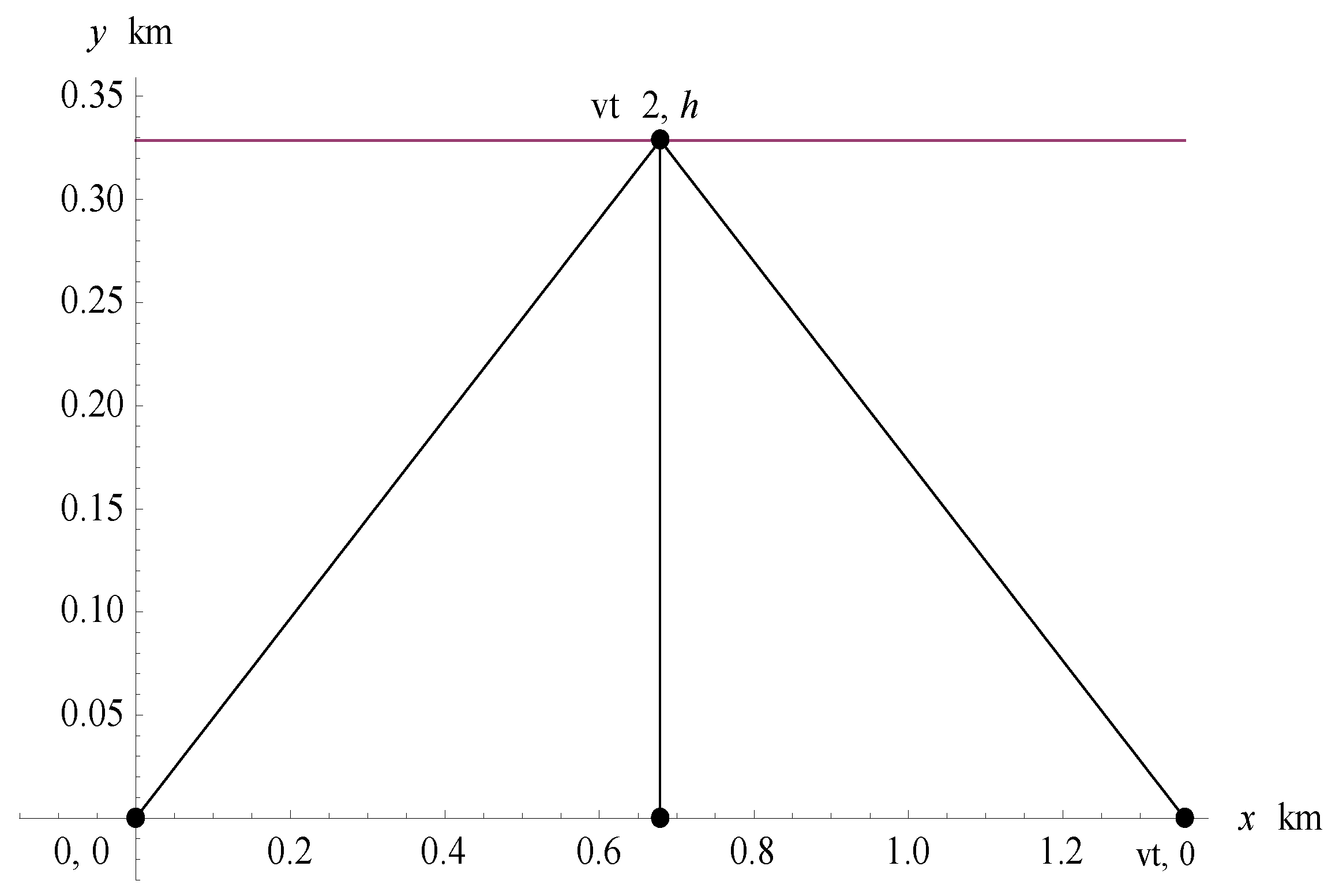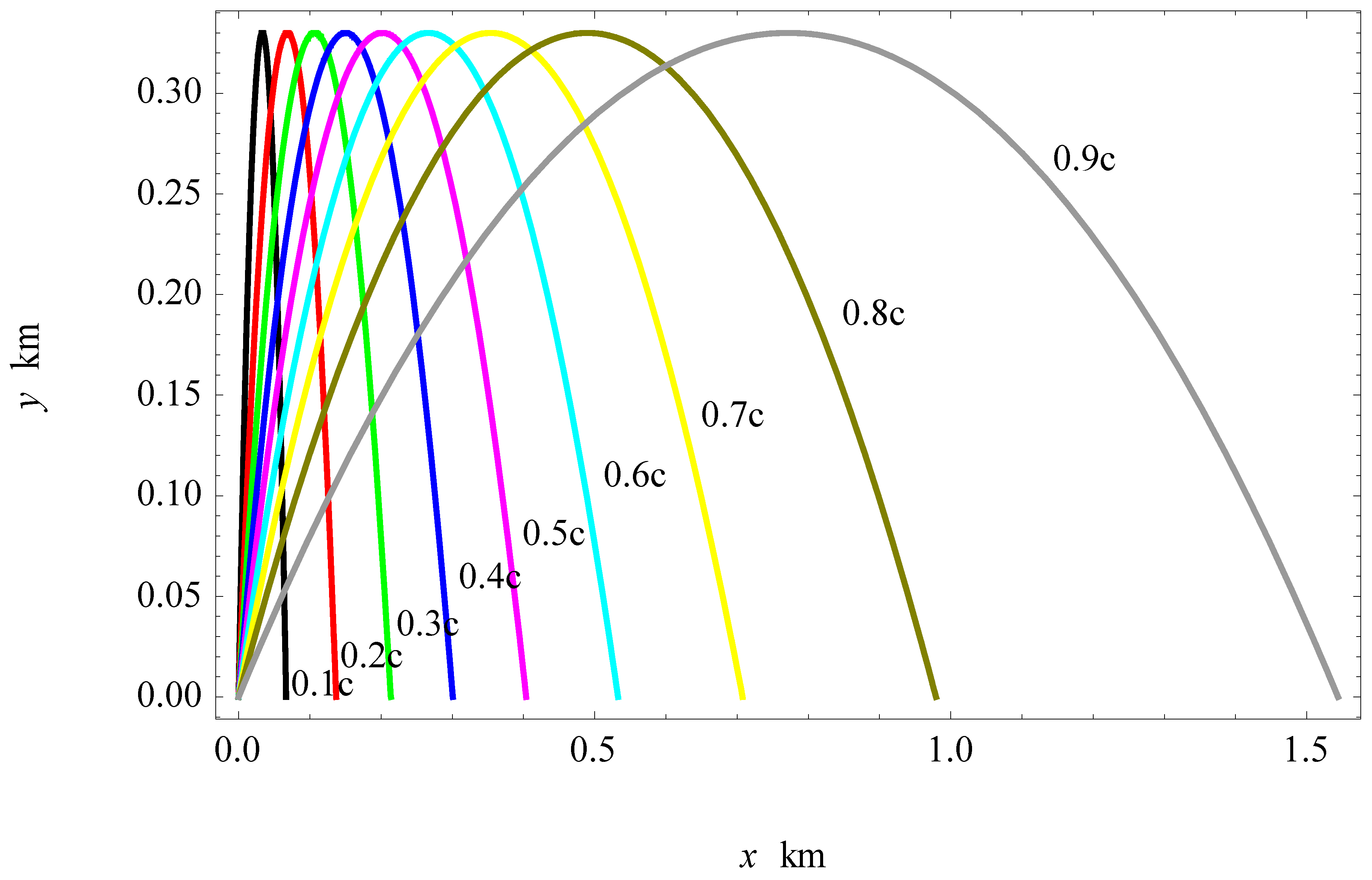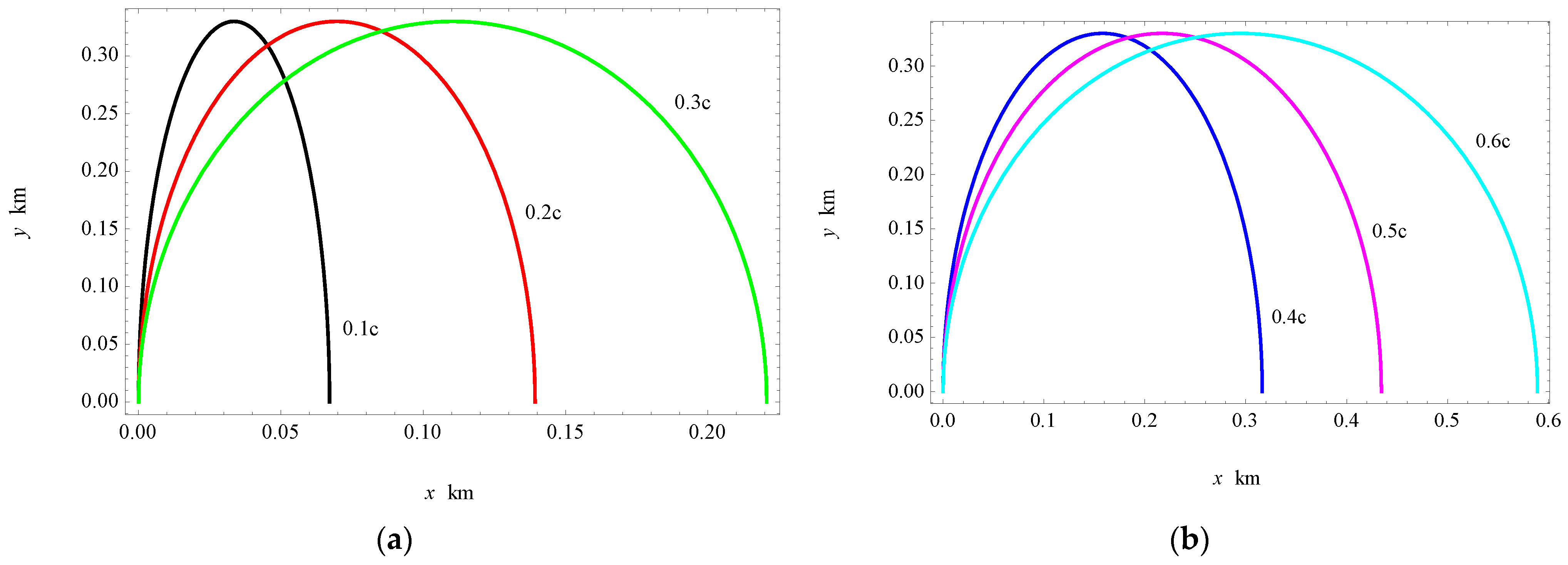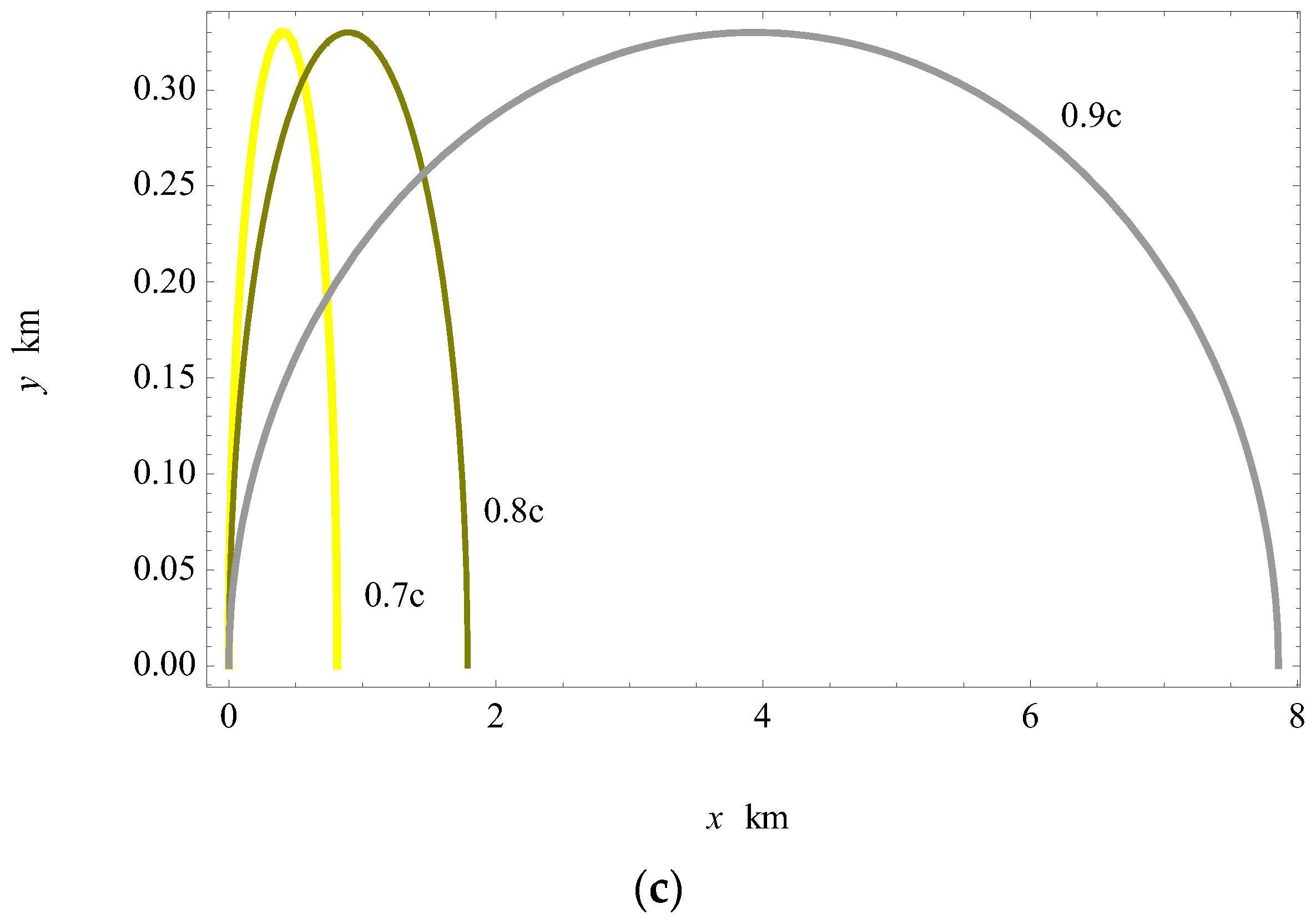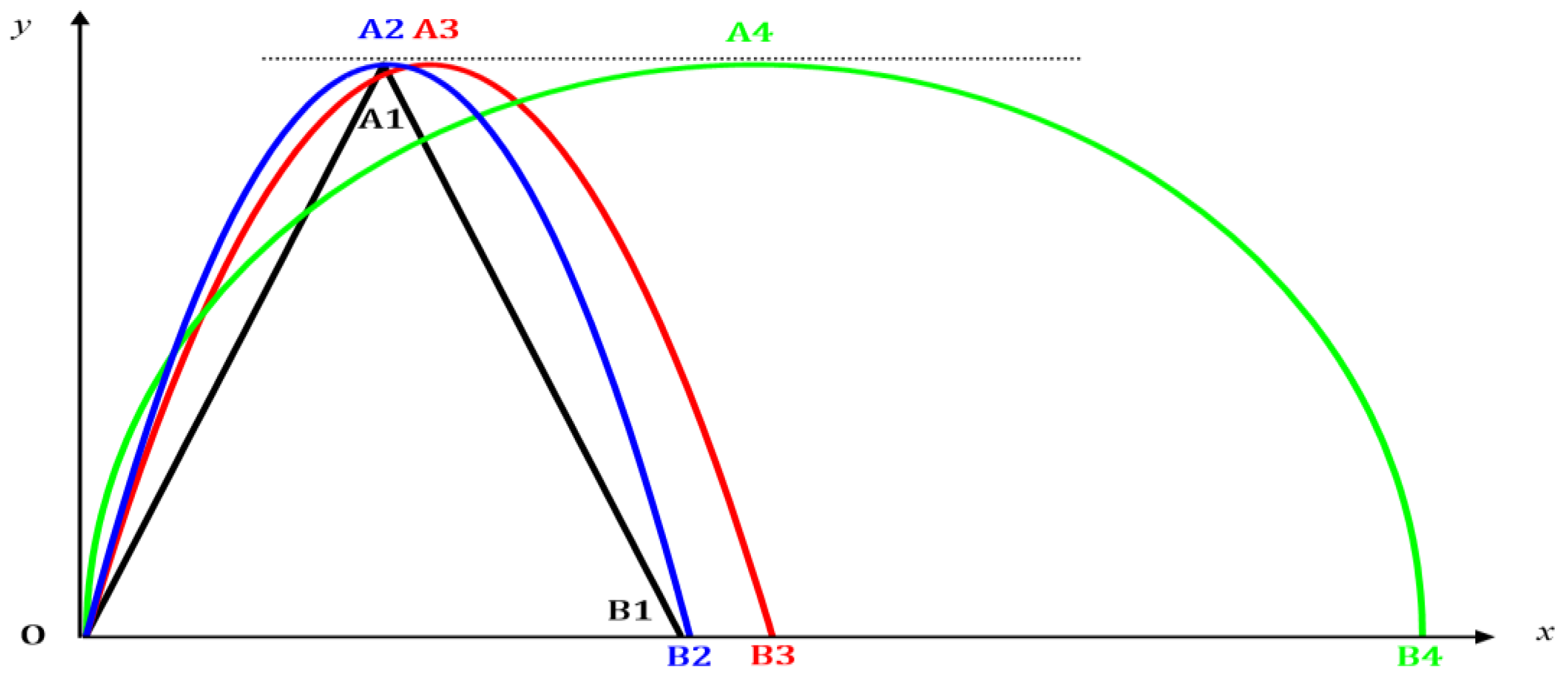1. Introduction
In this paper, the time dilation formulas in several trajectories are considered along with examining their accuracy. At the advent of the last century, Lorentz published his transformations [
1,
2] based on the ether theory. After that, Einstein developed his special theory of relativity based on a couple of fundamental assumptions [
3]. Then, Lorentz combined his transformations with Einstein’s formula and produced the well-known Lorentz-Einstein theory [
4]. Einstein’s geometrical derivation of time dilation was based on an observer in motion that notices the light propagation relatively in a straight line trajectory [
5,
6]. However, when such trajectory is changed to a curved trajectory, this observer will notice an enhancement in prolonging the lifetime of relativistic particles as fermions [
7]. Time dilation depends on acceleration energy and velocity of an object. The basic equation, Total energy (E
T) = kinetic energy (E
K) + potential energy (E
P), leads to the relativisitc factor
[
8], where
m0 is the rest mass and
c is the speed of light. According to Blokhintsev [
9] and Rédei [
10], it is suggested that the special relativity not only breaks down at very large distances due to gravitational effects, but also there may also be a breakdown below some fundamental distance
. Thus, the effect of such a breakdown on the muon lifetime in flight has been calculated by Rédei [
11] using a correction to the Einstein’s formula, given by
where
is the distance in centimeters such that
cm (95% confidence level). Lazanu [
12] concluded some elementary remarks about the time, mass and relativistic dynamics of quantum systems, while Budriga et al. [
13] simulated the protons and electrons acceleration. Tsipenyuk and Belayev [
14] discussed the photon dynamics in the gravitational field. Additionally, Mocanu [
15] investigated the trajectories of charged particles undergoing Brownian motion in a time variable magnetic field. Based on the CERN experiment [
16] for time dilation of muons, the authors declared that there is a fundamental difference between the theoretical and the experimental values, especially at velocities relatively close to the speed of light. They attributed the reason for such drawbacks to the particle trajectory, as it should follow a curved trajectory [
16]. However, the exact form of such a trajectory was not addressed. So, searching for an accurate equation for the particle trajectory has become a challenge. Especially, in quantum mechanics, the change of particle mass during the motion was not taken into account.
Actually, the mass increases as the velocity increases, and the mass reaches a very large value as the velocity of the particle approaches the speed of light. This increase in mass will inevitably lead to the effect of gravity on it. Consequently, a curved trajectory is expected, such as a projectile due to the gravitational effect on its mass [
17,
18]. The main reason for searching for other trajectories, different from the straight line, is simply to find an accurate description for particle trajectory as the authors in CERN experiment referred to. This is the main motivation of the current work. In addition, the authors of [
16] pointed out that the difference between the experimental results and Einstein’s time dilation formula becomes substantial, especially when the velocity approaches the speed of light. As far as we know, the CERN experiment in 1977 [
16] was the last practical experiment in that framework, while the maximum energy used, at that time, was 3 GeV.
It should be noted here that the energy of the CERN accelerator has reached 7 TeV in recent years. However, scientists never investigated this experiment again to conduct the time dilation of the muon particle under such high energy level (7 TeV). Reconducting the CERN experiment has become necessary in order to specify the reason for the fundamental difference between the experimental results and Einstein’s time dilation formula, especially because the higher energy (7 TeV) allows the particle to reach a velocity so close to the speed of light. This will contribute in specifying the fundamental breakdown in Einstein’s equation at very large velocities, as well as the exact form of the particle trajectory. In this study, we showed that the experimental values in ref. [
16] are closer to our results when the parabolic trajectory is considered. Perhaps this leads to a possible link between quantum mechanics and general relativity as a result of the increase in mass. This paper is an attempt to overcome the difficulties raised above. Determining a more liable formula for time dilation is the main target of this paper via considering several curved trajectories.
2. Basic Concepts and Equations
In the first part of this section, we address Einstein’s geometrical derivation of time dilation. Later in this section, we will introduce basic equations to reproduce the time dilation formula when a curved trajectory of a particle is considered. Einstein gave an example using a flashing light through the vertical axis
inside a train. In this case, an observer at rest (
) but in motion relative to an observer in horizontal pathway axis
, the vertical straight line trajectory of light turns into diagonal straight line trajectory, which is in the final Einstein’s formula of time dilation given as
. As an example, we give in
Figure 1 a representation of the obsereved straight line trajectory when
and
.
In this paper, we consider curved trajectories instead of the straight line trajectory followed by Einstein. In our case, light appears in a curved trajectory (as a portion of a parabola, an ellipse, and a circle) relative to observer in motion. As a result, we expect an increase in the time dilation of the particles. By the observer at rest (
), a beam of light cuts the distance
in a time
where
and the horizontal distance is
Based on the physical grounds, the possible curved trajectories of light should pass through the three points
,
, and
, where
and
are the velocity and the time of the moving observer, respectively. Consequently,
is given by
In trder to find the extended Lorentz fahis section, we search for several possible types of curved trajectories and study their effects on the time dilation. It should be noted that the total distance traveled by light in a time
is
, where
is the length of the arc, defined by
where
describes the curve, whether parabolic, elliptic, circular, or any another trajectory. In the following section, we will determine the time dilation formula corresponding to the parabolic trajectory. Furthermore, the time dilation formulas corresponding to the elliptic and the circular trajectories will be obtained in subsequent sections.
2.1. Parabolic Path
The path of the parabolic type is in the form
where
,
, and
are defined by
respectively. Accordingly, for the parabolic trajectory,
is expressed as
Applying the integral Formula (4) on the parabolic path (7), yields
where
Finally, substituting (8) in (3) and rearranging yields the following expression:
This equation is to be solved to obtain the extended Lorentz factor, . In a subsequent section, comparisons between and the standard Lorentz factor γ () will be performed as varies.
2.2. Elliptic Path
Suppose that the path is an ellipse with semi-minor and semi-major axes given by
and
, respectively, and consequently, the equation of the ellipse takes the form of
In order to find the extended Lorentz factor
for the elliptic path, we substitute Equation (12) in (4); this gives
where
is the elliptic integral, which is given by
Applying (13) in (3) gives
where
and
are already defined in Equation (9).
5. Results & Discussion
First of all, as
(i.e.,
), we observe from Equtaion (10) that
and accordingly, Equation (10), as (
), leads to
, i.e.,
. Although the analytical solution of Equation (10) is not available, the numerical solution can be evaluated at any given velocity of the moving observer. For example, the extended Lorentz factor
has been numerically calculated at different values of
v, utilizing the command ‘NSolve’ in MATHEMATICA and also comparing it to the standard Lorentz factor
, and the results are presented in
Table 1. The results reveal that the values of
(the extended Lorentz factor) are always greater than the values of
(the standard Lorentz factor) for the all cases. This means that the lifetime of unstable particles may be increased through the parabolic trajectory. In addition, in the experimental works of those in [
16,
19],
t0 (lifetimes of
and
were 2.1966
s and 2.1948
s, respectively) and
(lifetimes in flight of
and
were 64.419
s and 64.368
s, respectively, at
) with an average
for the
and
unstable particles. However, with the expected lifetime 63.3939
s, the expected value of
was 28.8718. It is found that, both of the expected lifetime (63.3939
s) and the experimental lifetime average (64.3935
s) are less than the present lifetime of the parabolic trajectory (73.1921
s), where
.
Graphically, the parabolic trajectories are shown in
Figure 2 at different velocities
when
. It can be seen in
Figure 2 that the curvature of the parabolic trajectory becomes significant as the velocity increases. For a declaration, the parabolic trajectory is closer to the straight line one at relatively lower velocities, such as
. For
, the difference between the curved trajectory and the straight line is clear and obvious. From this figure, it is also clear that the particle travels a longer horizontal distance than the corresponding one in a straight line due to the increase in the lifetime. This is because
, as shown in
Table 1. The difference in the value of the horizontal distance (
) can be calculated from the relationship
. Accordingly, such a difference increases as
increases. For the elliptic trajectory, the limit of (15) as
gives
and this yields
It is clear from Equation (24) that
when
. Although Equation (15) is an implicit transcendental equation in the extended Lorentz factor
, this equation can be accurately solved by any advanced software such as MATHEMATICA; in this regard,
Table 2 presents the numerical values of
for different values of
and compares them with the values of standard Lorentz factor
. The corresponding elliptic trajectories are displayed in
Figure 3a–c when
. It is seen that the time dilation of the elliptic trajectory and present parabolic trajectory has been increased over the straight line (the standard path of special theory of relativity), especially at
, where
, and the lifetime of the muon particle equals 142.899
s.
Regarding a circular trajectory, the solution of Equation (19) or Equation (20) is not unique at some given values of
. For example, when
, then Equation (19) or Equation (20) has multiple roots, such as Γ = 1.80664, 4.13974, 24.1561, and 55.3515. Similarly, when
, we obtain two roots given as
and
. Additionally, for muons particles; i.e., for
, there exist two possible values for the extended Lorentz factor given by
and
. Although the value
is too close to the unique value obtained by the parabolic trajectory, the other value
is unacceptable because
. Certainly, we can exclude values for
that are smaller than one for the muons particles with velocity
. However, on the other hand, it is important to note that all values of
are greater than one if muons particles take lower velocities, such as
and
. It is indicated above that all values of
are greater than one when
and
. It may be concluded that the cricular trajectory is still unique at the higher velocity
. Therefore, the present circular trajectory is acceptable for mouns moving with higher velocities (comparable to speed of light). Additionally, the circular trajectory may be useful in another case, such as the interpretation of time dilation as expected in quantum mechanics. The time dilation equation of Lorentz-Einstein cannot be utilized to explain the decay of unstable particles in quantum mechanics due to the occurance of fluctuations in time dilation, where
(acceptable) and, at the same velocity,
(unacceptable). Probable fluctuations occur in unstable particles due to a special trajectory of unstable particles as a reason for fluctuations in quantum mechanics [
20,
21]. Using the arithmetic mean method, we can find many curves formulas and obligate any particles to move in any path. Our new formula, which describes the relatively accurate trajectory corresponding to time dilation of muon particle, is closer to the CERNexperimental results [
16].
Table 3 shows numerical values of
for different values of
and compares them with the standard Lorentz factor
.
As a result, it can be concluded that the particles move relativity in a curved, not in a straight, trajectory, and it is restricted by Equation (21).
Figure 4 shows the geometrical difference between the trajectories of the standard straight line (black curve OA
B
), the current accurate trajectory (blue curve OA
B
), parabolic trajectory (red curve OA
B
), and the elliptic trajectory (green curve OA
B
) at
.
It is observed that the black straight line in special theory of relativity and the blue curve of the current study, resulting from Equation (21), pass (approximately) through the same three points with shifting amount in horizontal distance m. However, the horizontal and vertical points, which are shifted by some amounts for the parabolic and the elliptical trajectories, are equal to 2988.7506 m, 23,747.2564 m, respectively.
This means that the horizontal distance, traveled by unstable particles, mainly depends on the trajectory. Moreover, the elliptical trajectory gains the greatest value of lifetime and distance. Therefore, the lifetime of unstable particles can be enhanced by controlling their trajectories (if it is experimentally possible). The current results give some light on expanding the time dilation concept by considering different curved trajectories.
